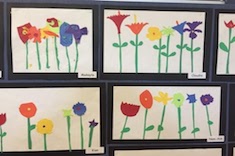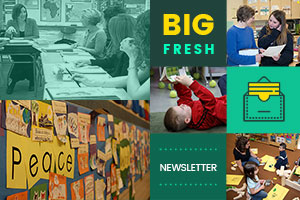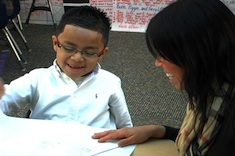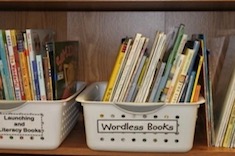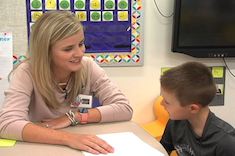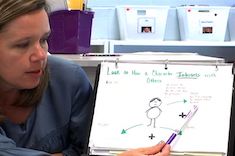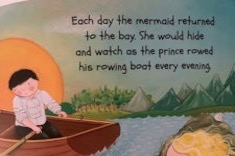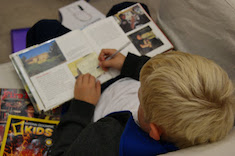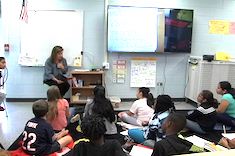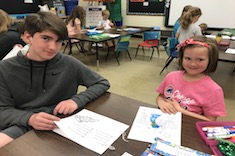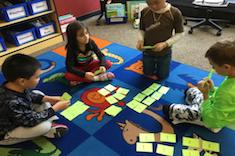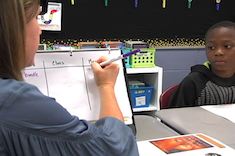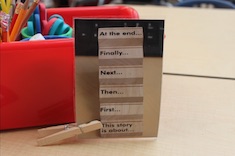Library
Choice Literacy Articles & Videos
The Choice Literacy library contains over 3,000 articles and 900 videos from 150+ contributors. Classic Classroom and Literacy Leadership subscribers have access to the entire library. Content is updated continuously, with five to six new features published each week.
Latest Content
Planting Rainbows
Bitsy Parks shares how she adapts her favorite first-grade spring literacy project for remote learning.
Letting Go in the Remote Learning World
Jen Schwanke, like many of us, is scrambling to deal with issues cropping up in the new world we all face of remote instruction. She shares some of the most common problems, and how teachers might deal with them.
March 27, 2020 New Plans
This week we look at teaching the youngest learners in literacy workshops.
First Grade ELL Conference: Writing and Pop Culture
Stella Villalba confers with first grade English language learner Eric about his writing on angry birds, with Esmeralda also sharing advice.
Book Selection for Early and Emergent Readers
Some emergent readers happily browse for books and explore them independently. For others, it’s a struggle. Cathy Mere shares her favorite strategies for helping all readers get comfortable with selecting books on their own.
Picture Walk Group in Kindergarten
Hayley Whitaker meets with a group of kindergartners and takes them through a picture walk.
The Good Part of Tech
Bitsy Parks shares how she integrates technology into her workshops with first graders in a way that is simple, effective, and natural.
Interpretation and Comprehension
Teaching comprehension skills can be a complex and overwhelming task. Tammy Mulligan shares a process for expanding and deepening student interpretations of text.
Fifth-Grade Group: Understanding Characters
Dana Murphy meets with a group of fifth graders to explore character development in their reading.
Building Primary Writing Skills Through Character Study
Jennifer Allen upends the normal routines in a primary writing workshop to introduce students to a compelling character.
March 13, 2020 Learn to Care
This week we look at teaching about characters in literacy workshops.
March 6, 2020 At Least No One Died
This week we look at self-assessment, the final installment in our two-part newsletter series on assessment.
First-Grade Guided Group: Reading Practice and Recap
Melissa Atwood leads a first-grade guided reading group. This is the second video in a two-part series.
Remembering the Big Picture in Reading Assessments
Kate Mills notes her own miscues in reading a bedtime story to her young children, and thinks about what that means for analyzing the running records of readers in primary classrooms.
Making Learning Stick: Learning Progressions and Student-Created Exemplars
Tammy Mulligan explains the process of having students analyze and create models of good writing and analysis for assessing themselves and peers.
February 28, 2020 Strengths Focused
This week we look at integrating test prep into literacy workshops.
Can a High-Stakes Assessment Create Readers?
Stephanie Affinito encounters an unexpected by-product of testing for her son—the uninterrupted reading time waiting for others to finish builds a good habit. She shares how teachers might reclaim 10 minutes a day for independent reading.
Teaching Constructed Response Before Exams
Teaching the genre of tests can seem far removed from writing workshop. Matt Renwick explores how to teach constructed response in a way that is integrated with the tenets of good workshop instruction.
February 21, 2020 A Place for Writing
This week we look at how to create cozy and safe learning spaces.
Minilesson: Revising Writing
Dana Murphy leads a minilesson in fifth grade on revising narrative writing.
Don’t Force Vulnerability
Ruth Ayres eavesdrops on some moms complaining about homework assignments, and finds the experience leads to reflection on the dangers of forcing students to make themselves vulnerable in classrooms.
Creating a Safe Space in Middle School
Christy Rush-Levine ponders what it means to create a safe space for all of her middle school students, and then makes some changes.
First Graded Guided Group: Chunking Words
Melissa Atwood leads a first-grade guided reading group. The focus at the start of the lesson is on chunking words. This is the first video in a two-part series.
February 14, 2020 The Poem in Your Heart
This week we look at how to foster a love of poetry in literacy workshops.
Poetry and Pastiche
Tara Barnett and Kate Mills introduce their middle school students to pastiche, a technique of mimicking the craft of favorite poems and poets.
Kindergarten and Middle School Poetry Partnership
Middle schoolers and kindergartners forge friendships at Katherine Sokolowski’s school through a sweet poetry writing and sharing project.
February 7, 2020 Grammar’s Flexibility
This week we look at word learning in literacy workshops.
Quick and Easy Word Study Groups in First Grade
Bitsy Parks shares some of her favorite strategies for quick and meaningful word work groups in her first-grade classroom.
Fifth-Grade Vocabulary Group
Dana Murphy meets with a group of fifth graders to work on strategies for understanding unknown words.
Teaching Transition Words
Tara Barnett and Kate Mills work with a second-grade team to think through how best to teach transition words during a fairy tale unit, especially to students who are English learners.
Browse Content By
Type
Category
- Assessment Tools
- Big Fresh Archives
- Booklists
- Choice Numeracy
- Classroom Design
- Common Core
- Community Building
- Conferring
- Content Literacy
- Digital Literacy
- English Language Learners
- Equity
- Family Relations
- Free Samples
- Guiding Groups
- Leadership
- Literacy Coaches
- Mentor Texts
- Minilessons
- New Teacher Mentors
- Podcasts
- Poetry
- Quote Collections
- Reading Strategies
- Self Care
- Struggling and Striving Learners
- Talking and Listening
- Teacher Study Groups
- Teaching Reading
- Teaching Writing
- Word Study and Vocabulary
Author
- Melissa Quimby
- Nawal Qarooni
- Gwen Blumberg
- Julie Cox
- The Lead Learners
- Hannah Tills
- Josie Stewart
- Ruth Metcalfe
- Mallory Messenger
- Becca Burk
- Jodie Bailey
- Vivian Chen
- Mary Brower
- Tiffany Abbott Fuller
- Stephanie Affinito
- Ruth Ayres
- Leigh Anne Eck
- Heather Fisher
- Shari Frost
- Julie Johnson
- Suzy Kaback
- Gigi McAllister
- Shirl McPhillips
- Melanie Meehan
- Cathy Mere
- Debbie Miller
- Tara Barnett and Kate Mills
- Tammy Mulligan
- Dana Murphy
- Bitsy Parks
- David Pittman
- Brenda Power
- Heather Rader
- Matt Renwick
- Mandy Robek
- Christy Rush-Levine
- Gretchen Schroeder
- Jen Schwanke
- Brian Sepe
- Katherine Sokolowski
- Stella Villalba
- Jennifer Vincent
Grade Level
Choice Literacy Membership
Articles
Get full access to all Choice Literacy article content
Videos
Get full access to all Choice Literacy video content
Courses
Access Choice Literacy course curriculum and training

